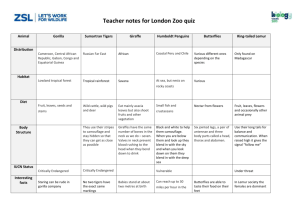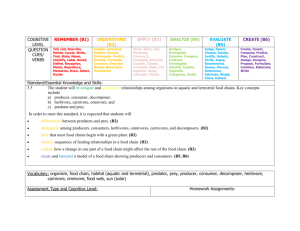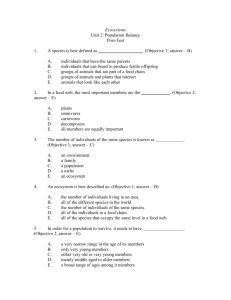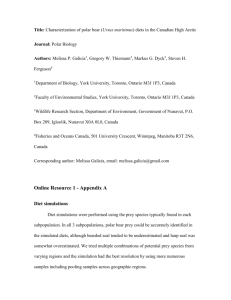What`s For Lunch? Outreach/Encounter
advertisement
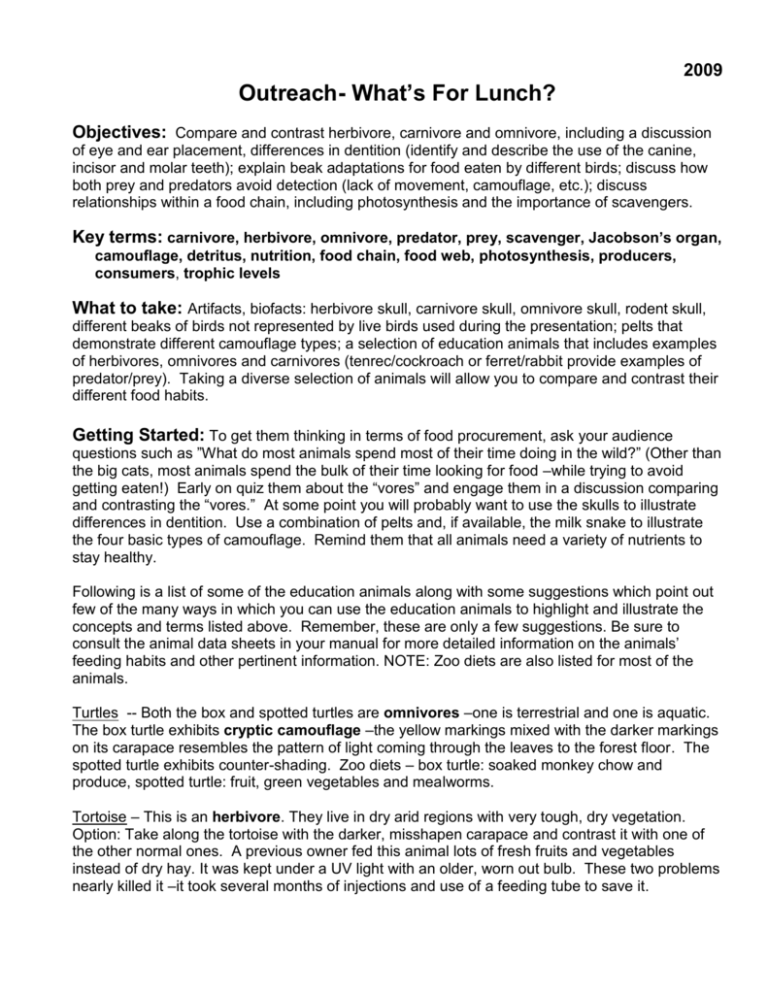
2009 Outreach- What’s For Lunch? Objectives: Compare and contrast herbivore, carnivore and omnivore, including a discussion of eye and ear placement, differences in dentition (identify and describe the use of the canine, incisor and molar teeth); explain beak adaptations for food eaten by different birds; discuss how both prey and predators avoid detection (lack of movement, camouflage, etc.); discuss relationships within a food chain, including photosynthesis and the importance of scavengers. Key terms: carnivore, herbivore, omnivore, predator, prey, scavenger, Jacobson’s organ, camouflage, detritus, nutrition, food chain, food web, photosynthesis, producers, consumers, trophic levels What to take: Artifacts, biofacts: herbivore skull, carnivore skull, omnivore skull, rodent skull, different beaks of birds not represented by live birds used during the presentation; pelts that demonstrate different camouflage types; a selection of education animals that includes examples of herbivores, omnivores and carnivores (tenrec/cockroach or ferret/rabbit provide examples of predator/prey). Taking a diverse selection of animals will allow you to compare and contrast their different food habits. Getting Started: To get them thinking in terms of food procurement, ask your audience questions such as ”What do most animals spend most of their time doing in the wild?” (Other than the big cats, most animals spend the bulk of their time looking for food –while trying to avoid getting eaten!) Early on quiz them about the “vores” and engage them in a discussion comparing and contrasting the “vores.” At some point you will probably want to use the skulls to illustrate differences in dentition. Use a combination of pelts and, if available, the milk snake to illustrate the four basic types of camouflage. Remind them that all animals need a variety of nutrients to stay healthy. Following is a list of some of the education animals along with some suggestions which point out few of the many ways in which you can use the education animals to highlight and illustrate the concepts and terms listed above. Remember, these are only a few suggestions. Be sure to consult the animal data sheets in your manual for more detailed information on the animals’ feeding habits and other pertinent information. NOTE: Zoo diets are also listed for most of the animals. Turtles -- Both the box and spotted turtles are omnivores –one is terrestrial and one is aquatic. The box turtle exhibits cryptic camouflage –the yellow markings mixed with the darker markings on its carapace resembles the pattern of light coming through the leaves to the forest floor. The spotted turtle exhibits counter-shading. Zoo diets – box turtle: soaked monkey chow and produce, spotted turtle: fruit, green vegetables and mealworms. Tortoise – This is an herbivore. They live in dry arid regions with very tough, dry vegetation. Option: Take along the tortoise with the darker, misshapen carapace and contrast it with one of the other normal ones. A previous owner fed this animal lots of fresh fruits and vegetables instead of dry hay. It was kept under a UV light with an older, worn out bulb. These two problems nearly killed it –it took several months of injections and use of a feeding tube to save it. Lizards -- The bearded dragon and blue-tongued skink are both omnivores and the sheltopusik is a carnivore –all three exhibit cryptic camouflage. Explain the use of their tongues and Jacobson’s organ. The sheltopusik also has a lateral line –a sense organ (touch) that helps it find its way underground or through the leaf litter in search of food. Zoo diets –bearded dragon and blue-tongued skink: fruits and vegetables, crickets and wax worms; sheltopusik: crickets, mealworms and young mice. Snakes – carnivores; loosely hinged jaw for swallowing large prey. Some snakes just catch prey with their mouth and swallow it, some are constrictors, and some are venomous. Jacobson’s organ; camouflage type depends on which snake you take (cryptic or mimicry). Zoo diet: rodents offered weekly. Parrot -- herbivore, strongly hinged and sharply hooked beak for cracking open nuts and getting through the tough skins of fruits; excellent color vision; zygodactylic foot (2 toes facing forward and 2 toes facing rearward –used for grasping limbs and climbing; cryptic camouflage. Zoo diet: commercial parrot diet, hard-boiled eggs, peanuts, and produce. Ring-necked Doves: herbivore; They have a specialized beak for consuming seeds; like most birds they have a crop (elastic food storage pouch located in the neck); herbivorous birds need grit in their muscular stomach called a “gizzard” to break up foods in their digestive system because birds have no teeth. Zoo diet: dove food mix Armadillo –insectivore, a specific type of carnivore; have only a few molars –used to crunch up the small insects that make up most of their diet in the wild; they have a long, sticky tongue that is used to capture insects such as ants and termites; they have very long, sharp claws on their front feet which are used to dig up their prey; body is protected from predators by its “armor: --which is comprised of modified skin and bone. Three banded armadillos are the only species which can completely roll their body into a ball. Zoo diet: Insectivore diet and wax worms. Tenrec – insectivore, a specific type of carnivore; specialized incisors act like fangs to capture and kill hard-shelled insects; poor eyesight, but keen hearing and sense of smell; specialized, prickly hair to protect it from predators; cryptic camouflage. Zoo diet: dry cat food, wax worms and crickets. Pair this animal up with the hissing cockroach and you have a good lead-in to discuss predator/prey, food chains, and food webs. Chinchilla –herbivore; eye and ear placement common to prey; cousins to rodents, they need to chew on hard foods to properly wear down upper incisors which continue to grow throughout its lifetime; cryptic camouflage. Zoo diet: chinchilla chow and alfalfa hay. Ferret – carnivore; eye and ear placement typical of mammalian predators; special adaptations for pursuing burrowing animals; show canine teeth (if possible); cryptic camouflage; Zoo diet: dry, specialized ferret food. Rabbit -- herbivore; note placement of eyes and ears, typical of prey species; rabbits produce two types of fecal pellets –soft ones which are re-ingested (to get more nutrition from their poorly digested food (eating of feces is called coprophagy) and firm pellets which are not re-ingested. Note: you can pair up the rabbit with the ferret to discuss predator/prey. Food chains food webs, etc. Zoo diet: pelletized rabbit food, hay. Opossum – This omnivore will eat anything that doesn’t eat it first. They have more teeth than any other land mammal –52! Opossums are often scavengers, feeding on dead animals. Ask your audience if they can name other scavengers (vultures, crows –even bald eagles occasionally scavenge). Zoo diet: dry cat food and produce. Raptors – “raptor” means killing with a claw –these birds are often called ”birds of prey” because as predators they depend on prey for their food. This group includes hawks, owls, falcons, eagles etc. They all have specialized eyesight, a hooked upper bill and are carnivores. Compare and contrast the different hunting styles of diurnal vs. nocturnal raptors. Zoo diet: commercial bird of prey diet and mice (eagle gets fish, too) Be sure to discuss the crucial role of photosynthesis and for upper elementary students include a conversation about producers, consumers and trophic levels. Middle/High school: In addition to more depth and detail with the above topics, you can add discussion of the following terms and concepts: carnassial teeth, apex predator, biomagnification, simultaneous calving, coprophagy, ruminants. carnassial teeth: These large, pointy teeth (premolar and first molar), found in many carnivorous mammals, are used for shearing flesh and bone in a scissor or shear-like way. Many modern carnivorans, e.g. lions, eat meat from other vertebrates or invertebrates and have welldeveloped carnassial teeth. In others, the carnassial teeth have become adapted to an herbivorous or to an omnivorous, mixed diet of meat and vegetable. The premolars and molars of modern bears are modified to grind vegetable matter. apex predator: apex predators (also alpha predators, or top-level predators) are predators that, as adults, are not normally preyed upon in the wild by other large animals in significant parts of their range. Apex predator species are often at the end of long food chains, where they have a crucial role in maintaining the health of ecosystems. One study of marine food webs defined apex predators as greater than trophic level four. Food chains are often far shorter on land, with the top of the food chain limited to the third trophic level, as where such predators as the big cats, crocodilians, hyenas, wolves, or giant constrictor snakes prey upon large herbivores. Such also applies to such omnivores as grizzly bears and humans that eat considerable vegetable material as well as much meat but are not themselves prey in most of their range. biomagnification: This is the accumulation of a substance up the food chain by transfer of residues of the substance in smaller organisms that are food for larger organisms in the chain. It generally refers to the sequence of processes those results in higher concentrations in organisms at higher levels in the food chain (at higher trophic levels). These processes result in an organism having higher concentrations of a substance than is present in the organism’s food. synchronized calving: A strategy utilized by several species of large ungulates in which most of the population gives birth within a very short period of time. In the Serengeti in Africa, 500,000 wildebeest calves are born within a 2-3 week period. In northern Canada and Alaska, 80-90% of all caribou calves are born within a ten day period in early June. The synchronization serves two important functions: it reduces the chance that an individual calf will be killed by predators and calving almost always coincides with the peak abundance of nutritious plants. coprophagy: This is a behavioral digestive process seen in rabbits, hares, guinea pigs, most rodents and several other mammal species. Literally translated, coprophagy means “feces ingestion.” However, in the species mentioned above it involves the production of special “soft pellets” in the cecum, which maintains cultures of beneficial bacteria. These soft pellets have twice the protein, and half of the fiber of the typical hard fecal pellet. They also contain high levels of vitamin K and the B vitamins and are usually immediately ingested after being expelled. ruminants: Ruminants have a fore-stomach with four chambers. These are the rumen, reticulum, omasum, and abomasum. In the first two chambers, the rumen and the reticulum, the food is mixed with saliva and separates into layers of solid and liquid material. Solids clump together to form the cud (or bolus). The cud is then regurgitated, chewed slowly to completely mix it with saliva and to break down the particle size. Plant fibers, is primarily broken down in these chambers by microbes (bacteria, protozoa, and fungi). Ruminating mammals include cattle, goats, sheep, giraffes, American Bison, European bison, yaks, water buffalo, deer, camels, alpacas, llamas, wildebeest, antelope, and pronghorn.
